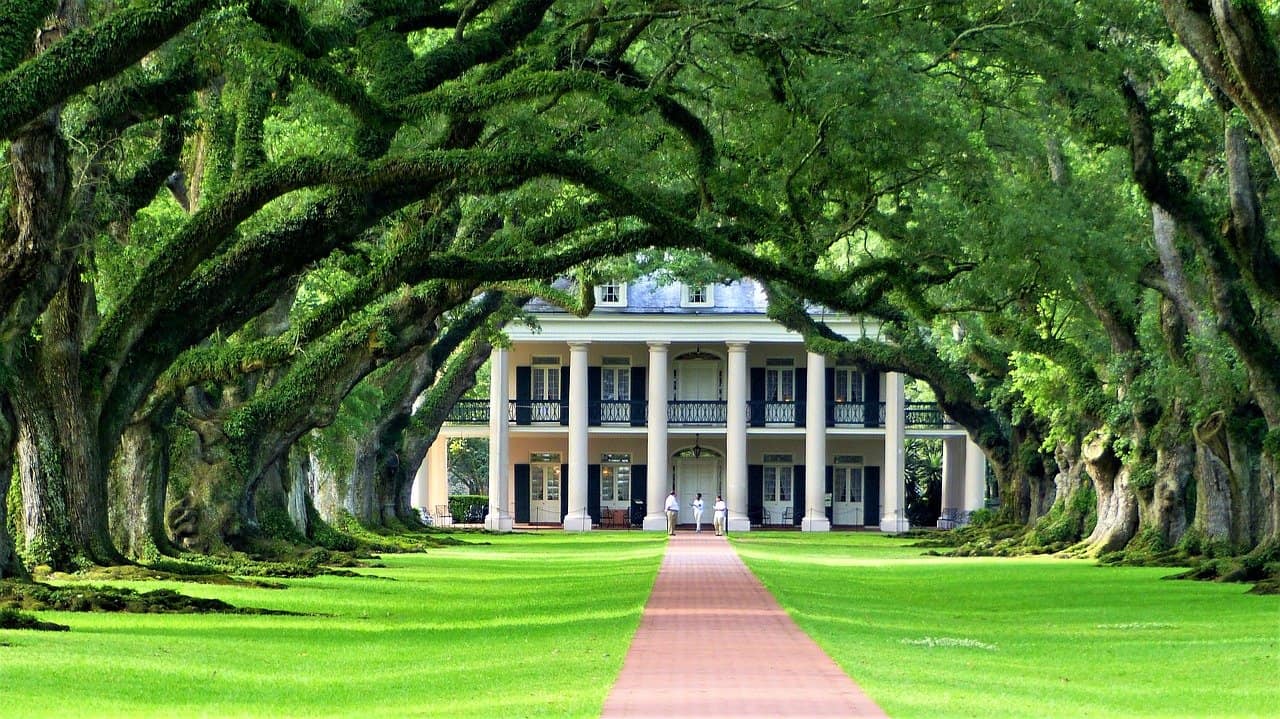New Orlean is a city with a unique atmosphere. Its vibrant history gathers some of the Gulf of Mexico’s most significant events and the US’s South-Eastern region. The city’s cultural print unites the local Creole culture, French and Spanish colonial traditions, and modern American influences. This unique mix attracts tourists from other US states and numerous countries across the world.
Upon arriving in New Orleans, tourists can choose one of two main sightseeing routes: getting to know the city’s neighborhoods and visiting the surrounding Louisiana plantations. In this article, I’ll focus on the latter.
Plantations of yore
Within a short driving distance from New Orleans, dozens of spectacular plantations tell the story of the past’s local agrarian billionaires. Roughly 200-300 years ago, the Antebellum South was the wealthiest region in the country. Cotton was the king, and plantations made the local families unbelievably rich for the time. Thus, the area is the center of grand mansions waiting to be explored. The local historical and cultural heritage surpasses even the streets of Nother city we’ve mentioned. Visit Savannah to compare the locations.
Leaving the city and its buzzing streets, you move from the melting heat of New Orleans to the breezing grounds of plantations and gardens. Such a trip brings you to the time of solemn dowagers, young girls in puffy dresses, grand balls, smartly-dressed men with cigars, carriage rides, and the first steps of colonization. It’s a story of beauty and disaster at the same time. The one that can’t be missed.
Each of those New Orleans plantation tours would give you a glimpse of the life of the past, but the following mansions and grounds have just something more to show; something intangible that fills your senses with the spirits of the past.
Oak Alley Plantation
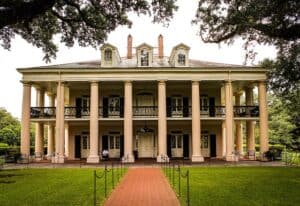 This plantation lives up to its name in full glory. The entryway to the grand mentioned features two rows of mighty oaks leading right up to the mansion. To my mind, this is the personification of the Antebellum era. In this place, you get the distant feeling of diving into the 19th century daily rituals with Scarlet O’Hara wandering the halls searching for her beloved Ashley. Any movie enthusiast would be delighted to step a foot on the grounds with a Gone with the Wind atmosphere, but the one depicted in Interview with a Vampire and Hush, Hush Sweet Charlotte.
This plantation lives up to its name in full glory. The entryway to the grand mentioned features two rows of mighty oaks leading right up to the mansion. To my mind, this is the personification of the Antebellum era. In this place, you get the distant feeling of diving into the 19th century daily rituals with Scarlet O’Hara wandering the halls searching for her beloved Ashley. Any movie enthusiast would be delighted to step a foot on the grounds with a Gone with the Wind atmosphere, but the one depicted in Interview with a Vampire and Hush, Hush Sweet Charlotte.
Oak Alley Plantation holds regular tours for groups of tourists and features a few exhibits in the mansion itself. This National Historic landmark was initially called Bon Sejour Plantation and owned by Jacques and Celina Roman. Today, the visitors are free to roam the rounds visiting several landmarks that exhibit the former place of sugar cane manufacture and the slavery history of the land.
The local guides share fascinating and tragic stories about the residents and slaves living on the grounds. I highly recommend sticking to a guided group for a while to get a better understanding of the local life at the time. Oak Alley Plantation tours: 9:30am-5pm.
Laura Plantation
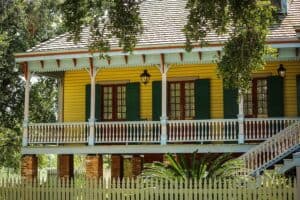 Another prominent plantation and mansion of the region initially belonged to André Neau in the early 18th century. Aside from the typical construction influence of European tendencies, Laura Plantation features a significant number of Creole-style buildings. Louisiana African American Heritage Trail included the site for its historical prominence.
Another prominent plantation and mansion of the region initially belonged to André Neau in the early 18th century. Aside from the typical construction influence of European tendencies, Laura Plantation features a significant number of Creole-style buildings. Louisiana African American Heritage Trail included the site for its historical prominence.
The guided tours cover a bit of the Laura land and last for slightly more than an hour, covering the stories of the generations of slaves (also walking by the numerous slave cabins) and the plantation owners. Tours start every hour, 1-am-4pm.
All in all, this is a very informative tour. However, there is also an option for a self-guided tour. To get the historical facts right, visit the overseer’s cottage that holds a museum-like exhibition.
St. Joseph Plantation
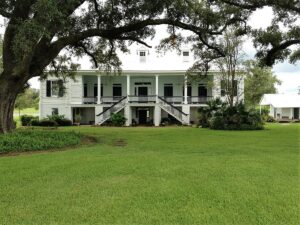
- Though not as famous as the previous two plantations near New Orleans on the list, St. Joseph Plantation has something about it that captures my interest. Maybe, it’s the whiteness and the main building that works beautifully in contrast with the surrounded greenery. Perhaps, it’s the well-executed tour around the grounds that dives a bit deeper than the plantation owners’ history. It takes a look at the history and tendencies of the whole region and the intricacies of sugarcane production.
Speaking of the owners, the grounds initially belonged to Josephine Aime Ferry. Today, it’s maintained and presented by the descendants of its second owners, the Waguespack and Simon families. This plantation is adjacent to the Oak Alley Plantation. Thus, I’d recommend visiting them one by one. Of course, this one can’t compare with the Oak in its grandeur, but the atmosphere makes up for what it’s lacking.
The guided tours run from 9:30 am to 4 pm.
Nottoway Plantation
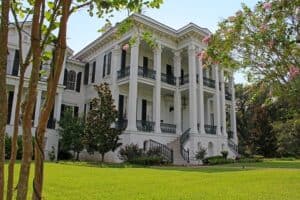 If you are looking for the grandest mansion in the area, I’d recommend visiting the Nottoway Plantation. The largest and most magnificent Antebellum home of all South stands in Nottoway. If the pure whiteness of St. Joseph’s main house impressed you, this one will amaze you with its brightness. The brilliant combination of Greek and Italian styles resulted in an impressive home with 64 rooms that encompass 53,000 square feet.
If you are looking for the grandest mansion in the area, I’d recommend visiting the Nottoway Plantation. The largest and most magnificent Antebellum home of all South stands in Nottoway. If the pure whiteness of St. Joseph’s main house impressed you, this one will amaze you with its brightness. The brilliant combination of Greek and Italian styles resulted in an impressive home with 64 rooms that encompass 53,000 square feet.
The Nottoway owner, John Hampden Randolph, strived to build the finest house along the Mississippi River. And he managed the task.
Today, this is more than a museum-like site with tours running all day long. This is an actual inn and resort site that you can enjoy for a few days and explore all those 64 rooms (cause the task is hardy manageable in just one day.) It is an important place among the Historic Hotels of America.
Each one of these plantations bears a vivid footprint of the 18th-19th century history. The South at the time was a place of grandeur and misery combined. These Louisiana plantations bear a vital part of the African American Heritage in the region. The tours around the sites reveal numerous slave cabins alongside the sad stories of their dwellers and the general history of slavery in New Orleans.
Louisiana plantations give not only a look at the past but also bring you closer to the current pop culture. You’ll be surprised to meet so well-known locations from such titles as Django, 12 Years a Slave, the Skeleton Key, Interview with a Vampire, The Curious Case of Benjamin Button, and others.

